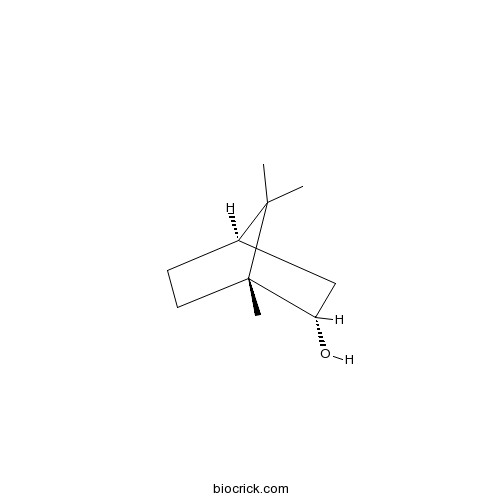(+)-BorneolCAS# 464-43-7 |

- Isoborneol
Catalog No.:BCN7158
CAS No.:124-76-5
- (-)-Borneol
Catalog No.:BCC8897
CAS No.:464-45-9
- Borneol
Catalog No.:BCN4964
CAS No.:507-70-0
Quality Control & MSDS
3D structure
Package In Stock
Number of papers citing our products

| Cas No. | 464-43-7 | SDF | Download SDF |
| PubChem ID | 6552009 | Appearance | Powder |
| Formula | C10H18O | M.Wt | 154 |
| Type of Compound | N/A | Storage | Desiccate at -20°C |
| Solubility | DMSO : ≥ 100 mg/mL (648.30 mM) H2O : < 0.1 mg/mL (insoluble) *"≥" means soluble, but saturation unknown. | ||
| Chemical Name | (1R,3S,4R)-4,7,7-trimethylbicyclo[2.2.1]heptan-3-ol | ||
| SMILES | CC1(C2CCC1(C(C2)O)C)C | ||
| Standard InChIKey | DTGKSKDOIYIVQL-WEDXCCLWSA-N | ||
| Standard InChI | InChI=1S/C10H18O/c1-9(2)7-4-5-10(9,3)8(11)6-7/h7-8,11H,4-6H2,1-3H3/t7-,8+,10+/m1/s1 | ||
| General tips | For obtaining a higher solubility , please warm the tube at 37 ℃ and shake it in the ultrasonic bath for a while.Stock solution can be stored below -20℃ for several months. We recommend that you prepare and use the solution on the same day. However, if the test schedule requires, the stock solutions can be prepared in advance, and the stock solution must be sealed and stored below -20℃. In general, the stock solution can be kept for several months. Before use, we recommend that you leave the vial at room temperature for at least an hour before opening it. |
||
| About Packaging | 1. The packaging of the product may be reversed during transportation, cause the high purity compounds to adhere to the neck or cap of the vial.Take the vail out of its packaging and shake gently until the compounds fall to the bottom of the vial. 2. For liquid products, please centrifuge at 500xg to gather the liquid to the bottom of the vial. 3. Try to avoid loss or contamination during the experiment. |
||
| Shipping Condition | Packaging according to customer requirements(5mg, 10mg, 20mg and more). Ship via FedEx, DHL, UPS, EMS or other couriers with RT, or blue ice upon request. | ||

(+)-Borneol Dilution Calculator

(+)-Borneol Molarity Calculator
| 1 mg | 5 mg | 10 mg | 20 mg | 25 mg | |
| 1 mM | 6.4935 mL | 32.4675 mL | 64.9351 mL | 129.8701 mL | 162.3377 mL |
| 5 mM | 1.2987 mL | 6.4935 mL | 12.987 mL | 25.974 mL | 32.4675 mL |
| 10 mM | 0.6494 mL | 3.2468 mL | 6.4935 mL | 12.987 mL | 16.2338 mL |
| 50 mM | 0.1299 mL | 0.6494 mL | 1.2987 mL | 2.5974 mL | 3.2468 mL |
| 100 mM | 0.0649 mL | 0.3247 mL | 0.6494 mL | 1.2987 mL | 1.6234 mL |
| * Note: If you are in the process of experiment, it's necessary to make the dilution ratios of the samples. The dilution data above is only for reference. Normally, it's can get a better solubility within lower of Concentrations. | |||||

Calcutta University

University of Minnesota

University of Maryland School of Medicine

University of Illinois at Chicago

The Ohio State University

University of Zurich

Harvard University

Colorado State University

Auburn University

Yale University

Worcester Polytechnic Institute

Washington State University

Stanford University

University of Leipzig

Universidade da Beira Interior

The Institute of Cancer Research

Heidelberg University

University of Amsterdam

University of Auckland

TsingHua University

The University of Michigan

Miami University

DRURY University

Jilin University

Fudan University

Wuhan University

Sun Yat-sen University

Universite de Paris

Deemed University

Auckland University

The University of Tokyo

Korea University
- Bay 55-9837
Catalog No.:BCC5932
CAS No.:463930-25-8
- alpha-Linolenic acid
Catalog No.:BCN8319
CAS No.:463-40-1
- Gnemonol B
Catalog No.:BCN3399
CAS No.:462636-74-4
- Lactulose
Catalog No.:BCC4669
CAS No.:4618-18-2
- 4beta,12-dihydroxyguaian-6,10-diene
Catalog No.:BCN7829
CAS No.:461644-90-6
- Dapagliflozin
Catalog No.:BCC2552
CAS No.:461432-26-8
- Ko 143
Catalog No.:BCC1684
CAS No.:461054-93-3
- Eact
Catalog No.:BCC6313
CAS No.:461000-66-8
- Larixyl acetate
Catalog No.:BCC8195
CAS No.:4608-49-5
- Interiotherin C
Catalog No.:BCN3636
CAS No.:460090-65-7
- Rucaparib (AG-014699,PF-01367338)
Catalog No.:BCC2207
CAS No.:459868-92-9
- 5-[(2R)-2-Aminopropyl]-2,3-dihydro-1-[3-(phenylmethoxy)propyl]-1H-indole-7-carbonitrile
Catalog No.:BCN1438
CAS No.:459868-73-6
- (-)-Borneol
Catalog No.:BCC8897
CAS No.:464-45-9
- (-)-Camphor
Catalog No.:BCN7160
CAS No.:464-48-2
- (+)-Camphor
Catalog No.:BCN7161
CAS No.:464-49-3
- Benzopinacol
Catalog No.:BCC8860
CAS No.:464-72-2
- Arenobufagin
Catalog No.:BCN5401
CAS No.:464-74-4
- Quinamine
Catalog No.:BCN6590
CAS No.:464-85-7
- Conquinamine
Catalog No.:BCN6622
CAS No.:464-86-8
- Asiatic acid
Catalog No.:BCN5506
CAS No.:464-92-6
- Pseudotaraxasterol
Catalog No.:BCN5507
CAS No.:464-98-2
- Arjunolic acid
Catalog No.:BCN5508
CAS No.:465-00-9
- Germanicol
Catalog No.:BCN7507
CAS No.:465-02-1
- Gamabufotalin
Catalog No.:BCN2358
CAS No.:465-11-2
Development and validation an LC-MS/MS method to quantify (+)-borneol in rat plasma: Application to a pharmacokinetic study.[Pubmed:30743141]
J Chromatogr B Analyt Technol Biomed Life Sci. 2019 Mar 1;1109:121-127.
(+)-Borneol, a bicyclic monoterpene, has been shown to possess valuable biological properties and potential as a pharmaceutical agent due to anti-inflammatory, anti-oxidant and GABA receptor-enhancing functions; it also enhances the permeability of the blood brain barrier to improve the efficacy of CNS drugs. In this study, we have developed a simple, selective, and rapid liquid chromatography-tandem mass spectrometry method for the assay of (+)-Borneol in rat plasma. Verapamil was used as an internal standard. Plasma samples were deproteinized using methanol. The analyte was detected by a mass spectrometer with positive atmospheric pressure chemical ionization by multiple reaction monitoring mode for transitions at m/z [M+H](+) 137.2-->81.0 for (+)-Borneol and 455.2-->165.1 for verapamil. The method has been fully validated to ensure good selectivity, a satisfactory lower limit of quantification at 10.0ng/mL, acceptable intra- and inter-day accuracy, and high precision. The method was used for the pharmacokinetic evaluation of (+)-Borneol in Sprague-Dawley rats after intravenous, oral, and sublingual administration. The results indicate that oral bioavailability of (+)-Borneol was extremely low but sublingual administration yielded rapid absorption and favorable bioavailability of (+)-Borneol.


